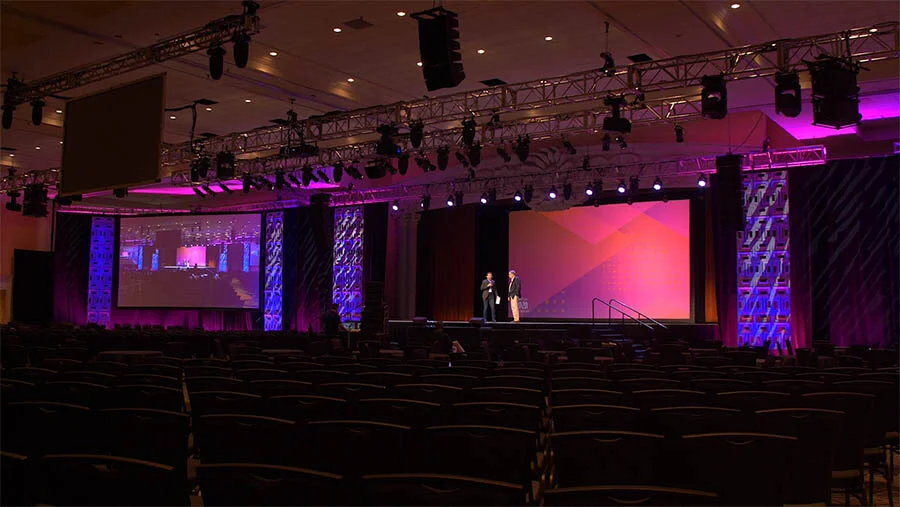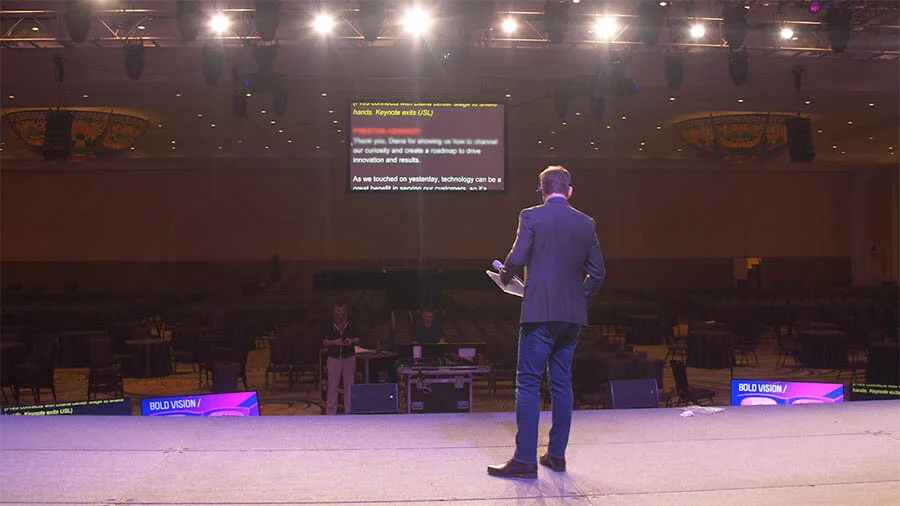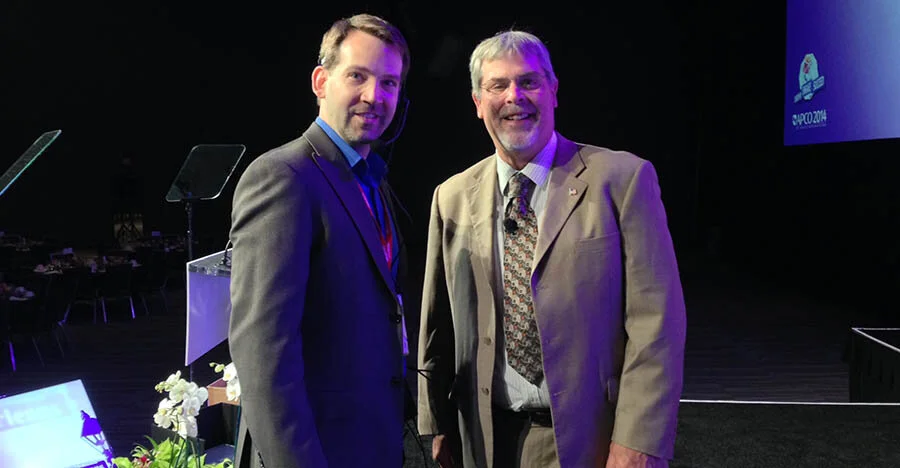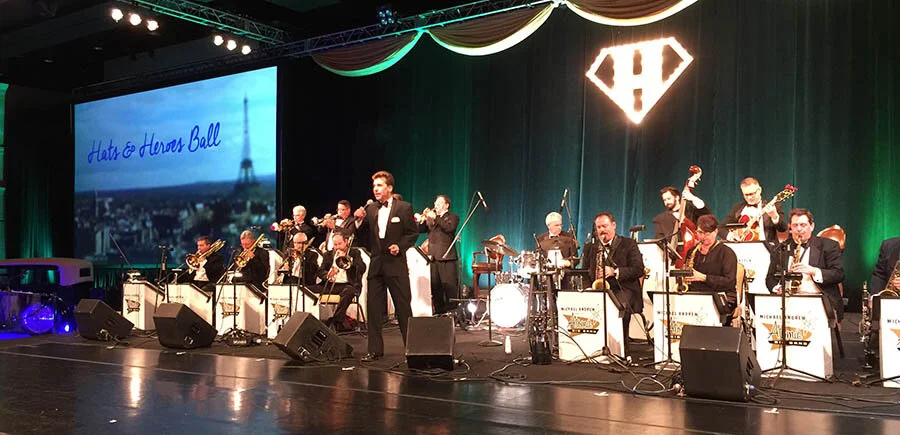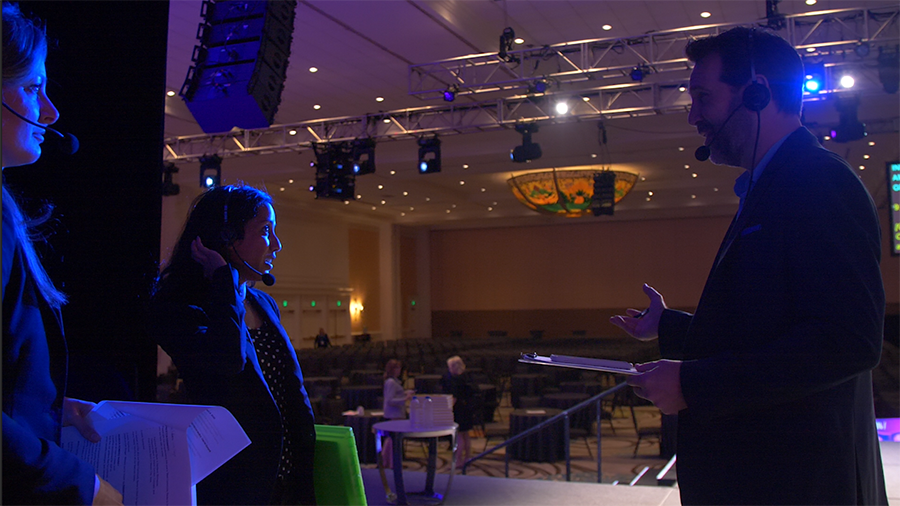Live Event Production
As you may have noticed by now, we do love producing live events. My background is in live professional theatre, so our philosophy of corporate events and association conferences is simple: “If there’s an audience, then it’s a show.”
Shows have stories to tell, performers to tell them, production values to support them, and they leave the audience with a new perspective - reflecting on a memorable experience.
“We have this room all week…I just feel like we should DO something with it, you know?”
So, in an effort to share the full range of our capabilities, this post contains a breakdown of our event services. We commonly approach events a la carte, so some or all of the services below may apply to any given event.
For reference, our scope of services is contained within what most meeting planners consider the ‘production’ element of an event.
Pre-Event Services
This is the stuff we do in the months leading up to the show.
Strategic session development – Over the course of several face-to-face meetings and/or conference calls, we generate recommendations and action plans for the various general sessions to maximize the impact to the audience. This process includes analysis of the organization and potential attendees, discussion of priorities, goals, themes, and the history of attendee expectations.
Show flow development – Armed with the information collected above, we develop a time-based spreadsheet tracking all elements and occurrences planned for the show to demonstrate their order and duration. This document is usually revised several times as the event itself comes together, and serves as an outline for the event script.
Script writing – With a solid show flow in hand, we write copy for each presenter as appropriate, interspersed with stage directions and call-outs for AV cues. Some presenters prefer to draft their own remarks, some want limited assistance, and some may simply want bullet points on the teleprompter. We compile all of this information into a complete narrative document reflecting the ideal presentation of the session or event. Scripting and polishing presenter remarks also gives us the opportunity to reinforce the theme of the session or event and/or enhance the host organization’s brand with key words, phrases, and strategic emphasis on various points.
Hmmm…how best to engage these attendees?
AV Consulting and Management – We do not provide elements like staging, scenery, lighting, video screens, projectors, microphones, and playback equipment, but we work closely with the host organization to help them vet and select the best possible AV partner (pro-tip: it’s rarely the in-house hotel AV department), assess real gear needs and their fair value, and then coordinate closely with that partner to ensure the right look and feel for the event. We can also contract our own ‘known entity’ AV partners for turnkey service.
Onsite Services
These are all the things we do once we’re there.
Rehearsal management – Our onsite team – usually consisting of a Show Director/Producer, a Stage Manager, and an ASM (Assistant Stage Manager) – will lead the AV team and all presenters (from professional keynote speakers to internal leadership) through their portions of the session or event. The process is scheduled and managed to optimize the use of everyone’s time, so that lighting and sound cues are not being rehearsed while a CEO is attempting to run through his or her remarks on teleprompter. Remember: to your audience, it’s a show, and a show is only as good as its rehearsal process.
How do you get to Carnegie Hall? Rehearsal, rehearsal, rehearsal.
Blocking – This is the process of staging the action, entrances, exits, handshakes, photo opportunities, award hand-offs, and all other stage business. These elements must be set and rehearsed with the AV team to ensure a smooth and polished presentation to the audience.
Presenter coaching – For internal presenters less experienced with public speaking, we customize a program of coaching to improve pace, tone, confidence, and audience engagement. This often includes private discussions before rehearsing onstage, and a variety of tips and tricks for everything from simulating audience eye contact for the IMAG cameras to using a presidential teleprompter for the first time.
Script and show flow management – The plan rarely stops evolving onsite, so we’re set up to track changes, make adjustments, and deliver new paperwork such as revised scripts and show timing on the fly.
Show calling – The stage manager on our onsite team ‘calls the show’, meaning he or she will be on headset with the AV and technical crew, the show director/producer, and all ASMs to cue music, video, graphics, and lighting, as well as presenter entrances. The stage manager, as a single point of contact, can also coordinate the response to the inevitable unplanned occurrences so we can recover quickly and minimize the impact to the show.
Presenter and talent wrangling – The ASM (or ASMs, depending on the size of the show) on our onsite team coordinates the backstage activity – managing presenter entrances and exits, guiding VIPs, preparing props such as special gifts and awards, and communicating status to the stage manager to keep things running smoothly in rehearsal and during the show.
Sometimes your presenter is the *real* Captain Phillips (Sorry, Tom Hanks)
Post-Event Services
And of course, these are the things we do after the show to make sure the next year will be even better.
Show flow analysis – Careful notes taken onsite can show us which elements ran short or long to help everyone understand the event itself and what to expect in the future as we compare them to the last version of the show flow. This is where tools like word-count planning can help shore up future sessions.
Post-mortem review and analysis – Our team will prepare a list of elements that we feel went well, and notes on what we think can be improved (this applies to our own processes as well as to the event in general). We’ll usually schedule a conference call with the host organization, and then submit our report for posterity.
Our feedback? Your show needs 60% more Michael Andrew.
Archiving – We permanently archive all data, from the pre-event documentation to the final teleprompter scripts (reflecting any changes made during final rehearsals) for future reference.
Event Video Services
We also do a fair amount of video work (you may have noticed that as well), so here are some additional services we offer to bring even more to your meeting, conference, or event experience:
Opening session and session content videos – Nothing gets an audience’s collective energy up like a rousing opening session video. It’s a great way to introduce and reinforce the theme, and serves as a record of how the event or session was introduced.
Attendee award videos – Breaking up the flow of an event by dropping the lights and rolling video is a great way to keep the audience engaged. With a pre-produced video you can honor an award winner while controlling the experience better than if you simply open the lectern for remarks, plus the video also becomes a keepsake for the award winner, an asset for social media, and a record for the host organization.
Pre-event promotional videos – These can be used to build awareness, drive registration, and sell an event to potential sponsors and exhibitors by previewing themes, graphics, and highlights, as well as showing them what to expect by quoting key information such as projected attendee count, planned keynote speakers and topics, and exciting locations.
Roving videography – The big cameras with long-throw sports lenses in the ballroom are part of the AV package, but our onsite video team can go handheld around the event, talking directly to attendees, exhibitors, sponsors, and even presenters to collect sound bites and archival/promotional b-roll. The resulting footage can be used to generate a wide variety of post-conference assets (described below), and can also be collected strategically to evaluate elements of the event. Consider it a video survey where the results can be cut together, assessed, packaged, and presented to a board or even to potential sponsors when looking to demonstrate a point or review an initiative.
Graphics packages – Like roving videography, good event photography means being there when the things happen. Golf tournaments, award shows, break-out sessions, exhibit halls, social events, off-site concerts and more are all cataloged visually. And also like videography, we can capture candid shots in the moment but also set up a portable studio for headshots with a more formal look and feel.
Post-event promotional video – Telling the story of an event afterwards can make for a great selling tool for future events. Attendees can see what their experience would be like, sponsors can see what sort of exposure they can expect in everything from attendee demographics to signage and logo presence, exhibitors can see what kind of layout and foot traffic they can expect, and even potential presenters can get a sense of who their audience would be. Plus, for posterity it’s great to have a stylish summary record of an event.
Documentary video – This type of piece is similar to the one described above but is usually longer and more comprehensive, often organized into chapters and incorporating a professional narrator to fully describe the event and all that it covered.
Vlog entry video – Collecting sound bites on targeted topics means that the footage from multiple sources (attendees, exhibitors and sponsors) can be assembled to tell a lot of different stories and help a host organization by filling the hopper with fresh, short-form social media content that’s easily sharable and on-message by design.
We’ve done a lot of these videos over the years. Hundreds, in fact. You can see samples here in the Live Event category of our video portfolio.
Alright, enough blogging for today…time to get back to work.
“Whaddaya say … want to do another show?”

